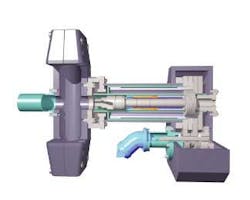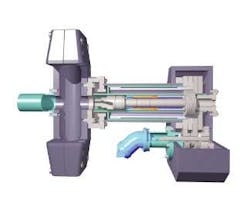Safety devices secure wells, pipelines following major incidents
Novel methods of sealing wells and pipelines in the event of a blow-out or damage caused by a terrorist attack have been launched by Well-Head Safety Systems. Three patents have been secured to protect the company's products, president Jan-Evert Lindmark reports.
Well-Head has completed the development of a safety device for use on oil wellheads and pipelines with an outer diameter of up to 14-in. The method has been demonstrated on a test rig and certified by Lloyd's Register. Development is ongoing of a second device employing the same principles, which is intended for use on pipelines up to 63-in. diameter.
Late last year the company signed co-operation agreements with various partners and is now planning a global campaign of promotion. "We're on the right track and we know that the big service companies accept the idea," Lindmark says.
In the case of an oil well the safety device may be fitted around the pipe beneath the wellhead. For this purpose an access tunnel and small chamber around the pipe have to be excavated and then protected by concrete walls. Alternatively the device may be fitted to a pipeline above ground, in which case it would need to be housed within a protective chamber.
While the well continues to operate normally, the device remains on standby. In the event that control of the well is lost due to a blowout or other occurrence, the device can be activated in a number of ways – by satellite, phone, from an aircraft, or manually.
The device consists of a piston set at right angles to the pipe and contained in a sealed box. At the head of the piston is a drill-bit – when the device is activated, the piston turns, driven by a high-pressure hydraulic power pack. The drill-bit is then pushed against the pipe, drilling a hole through the near wall and out through the farther wall into a sealed cylinder previously fitted to the outside of the pipe.
Behind the drill-bit an expansion unit is mounted on the piston. Once aligned with the inside of the pipe, this unit is activated and expands until it forms a sealed barrier across the pipe, thus stopping the flow. In the demonstration project, which was attended by Lloyd's Register, the device was tested in wellstream pressures of up to 600 bar, though the capacity is much higher.
The whole operation is reversible, as was also witnessed by Lloyd's. When the well is ready again for normal functioning, the expansion unit can be deactivated and the piston withdrawn from the pipe. The oil flow then resumes and there is no leakage.
It is important not to seal the pipe too quickly, Lindmark says – this would cause the wellstream to recoil and then return with much greater force, in the process destroying the seal. In fact the expansion unit takes several minutes to form the seal – in the case of a 5-in. OD pipe, about 12-15 minutes.
The safety device for gas pipelines with larger diameters has so far been tested at lower pressures, but there are plans to raise this to 200 bar.
The device is similar to the previous device in that it is mounted around the pipe and drills a hole through the two pipe walls by means of a drill-bit fitted on a piston. The sealing method is different, however. In this case a spindle is deployed from the piston and positioned parallel to the pipe. The spindle turns and winds round itself a tape drawn from a spool contained within the box housing the piston. The tape is made from a very hard but flexible compound material developed for space research purposes – when fully wound round the spindle it forms a tight and effective seal.
This process is also reversible. When the pipeline is ready to resume operation, the tape is unwound, the spindle folds back into the piston, and the piston is withdrawn from the pipe.
As the devices are remotely activated and monitored, reliable control and communication systems are clearly essential. This part of the development has benefited from Well-Head's connections with the telecommunications and defense sectors.
The cut-away shows Well-head Safety Systems' safety device mounted on a vertical pipe (left). At the center is the piston with a drill bit at its head, behind which is located the expansion unit (in orange).
null
Subsea applications
Lindmark sees potential for deploying the devices subsea. For such an application, the equipment would be contained within a steel sphere mounted around the pipeline and the air evacuated. In addition to the safety function, the devices could also be used for forms of pipeline intervention such as hot tapping, both off and onshore.
The development of the Well-Head Safety Systems products began in 1998. The basic idea for the invention came from a colleague of Lindmark's who was involved in suppressing the fires caused by the torching of oil wells in Kuwait by invading Iraqi forces in 1990. Since 9/11, it has become apparent that the devices are also applicable as a means of defense against terrorist attacks.
For more information, contact Jan-Evert Lindmark, Well-Head Safety Systems. Tel: +46 922 140 50, fax: +46 922 141 30. [email protected], www.well-head.com




